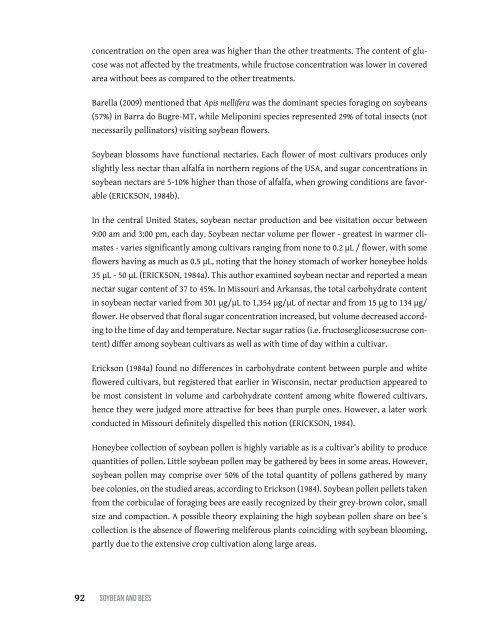Soybean and Bees
You also want an ePaper? Increase the reach of your titles
YUMPU automatically turns print PDFs into web optimized ePapers that Google loves.
concentration on the open area was higher than the other treatments. The content of glucose<br />
was not affected by the treatments, while fructose concentration was lower in covered<br />
area without bees as compared to the other treatments.<br />
Barella (2009) mentioned that Apis mellifera was the dominant species foraging on soybeans<br />
(57%) in Barra do Bugre-MT, while Meliponini species represented 29% of total insects (not<br />
necessarily pollinators) visiting soybean flowers.<br />
<strong>Soybean</strong> blossoms have functional nectaries. Each flower of most cultivars produces only<br />
slightly less nectar than alfalfa in northern regions of the USA, <strong>and</strong> sugar concentrations in<br />
soybean nectars are 5-10% higher than those of alfalfa, when growing conditions are favorable<br />
(Erickson, 1984b).<br />
In the central United States, soybean nectar production <strong>and</strong> bee visitation occur between<br />
9:00 am <strong>and</strong> 3:00 pm, each day. <strong>Soybean</strong> nectar volume per flower - greatest in warmer climates<br />
- varies significantly among cultivars ranging from none to 0.2 µL / flower, with some<br />
flowers having as much as 0.5 µL, noting that the honey stomach of worker honeybee holds<br />
35 µL - 50 µL (Erickson, 1984a). This author examined soybean nectar <strong>and</strong> reported a mean<br />
nectar sugar content of 37 to 45%. In Missouri <strong>and</strong> Arkansas, the total carbohydrate content<br />
in soybean nectar varied from 301 µg/µL to 1,354 µg/µL of nectar <strong>and</strong> from 15 µg to 134 µg/<br />
flower. He observed that floral sugar concentration increased, but volume decreased according<br />
to the time of day <strong>and</strong> temperature. Nectar sugar ratios (i.e. fructose:glicose:sucrose content)<br />
differ among soybean cultivars as well as with time of day within a cultivar.<br />
Erickson (1984a) found no differences in carbohydrate content between purple <strong>and</strong> white<br />
flowered cultivars, but registered that earlier in Wisconsin, nectar production appeared to<br />
be most consistent in volume <strong>and</strong> carbohydrate content among white flowered cultivars,<br />
hence they were judged more attractive for bees than purple ones. However, a later work<br />
conducted in Missouri definitely dispelled this notion (Erickson, 1984).<br />
Honeybee collection of soybean pollen is highly variable as is a cultivar’s ability to produce<br />
quantities of pollen. Little soybean pollen may be gathered by bees in some areas. However,<br />
soybean pollen may comprise over 50% of the total quantity of pollens gathered by many<br />
bee colonies, on the studied areas, according to Erickson (1984). <strong>Soybean</strong> pollen pellets taken<br />
from the corbiculae of foraging bees are easily recognized by their grey-brown color, small<br />
size <strong>and</strong> compaction. A possible theory explaining the high soybean pollen share on bee´s<br />
collection is the absence of flowering meliferous plants coinciding with soybean blooming,<br />
partly due to the extensive crop cultivation along large areas.<br />
92 SoybeAn <strong>and</strong> bees


